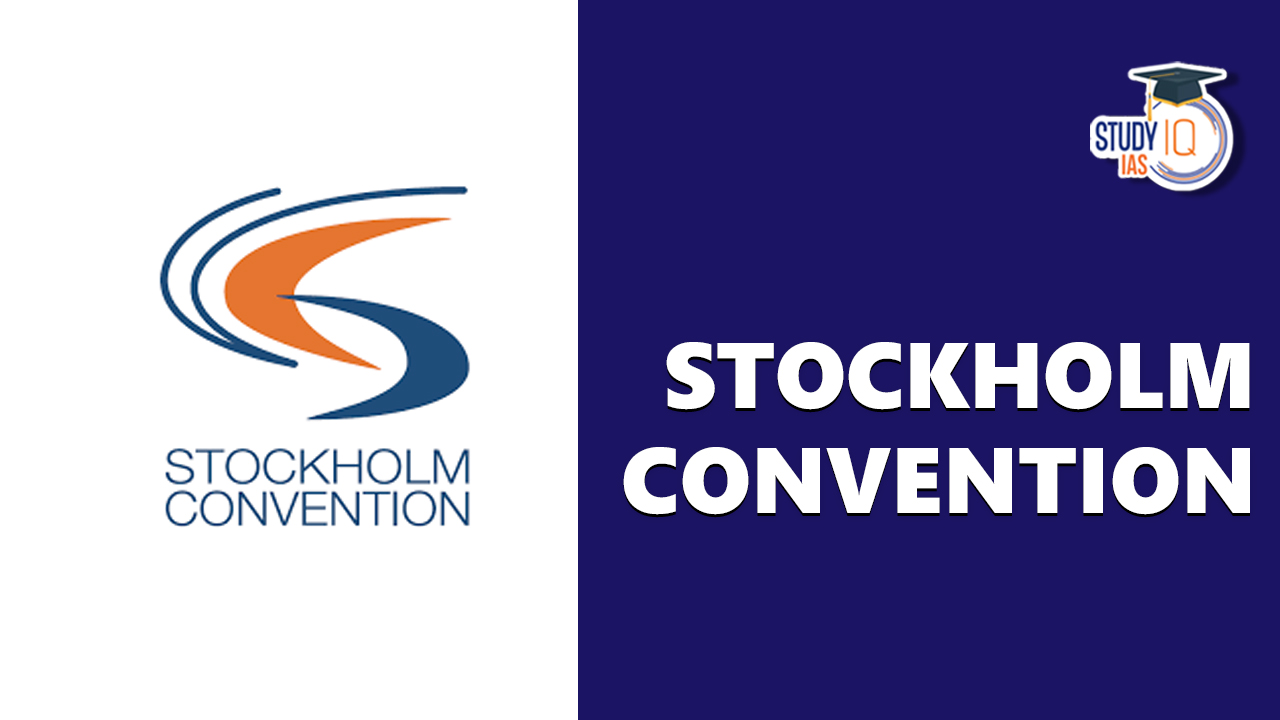Table of Contents
Stockholm Convention
A global agreement known as the Stockholm Convention was created in 2001 to safeguard both human health and the environment from persistent organic pollutants, or POPs. 2020 will see the ratification of seven substances listed under the Stockholm Convention on Persistent Organic Pollutants by the Indian Union Government. Persistent organic pollutants (POPs) are targeted for production restrictions and abolition under the Stockholm Declaration.
The subject of environment and ecology in the UPSC syllabus includes the crucial issue of the Stockholm Convention. We’ve covered all the key details and information about the Stockholm Convention in this post.
Also Read: List of Environment Conventions and Protocols
Stockholm Convention on Persistent Organic Pollutants
The Stockholm Convention, commonly referred to as the Stockholm Declaration, is a global agreement that was ratified on May 17, 2004, in Stockholm, Sweden, by the Conference of Plenipotentiaries. It is an international agreement to safeguard the environment and human health from POPs. The convention’s main goal is to actively limit or eliminate the use of persistent organic pollutants like lindane, chlordecone, etc.
- The duty of emerging and transitioning economies is to support other countries in implementing the Stockholm Convention measures adopted by the United Nations Industrial Development Organization.
- A global financial institution called the Global Environment Facility (GEF) offers funds to advance the Stockholm Convention.
| Stockholm Convention on Persistent Organic Pollutants | |
| Particulars | Details |
| Stockholm Convention adopted on | 2001 in Stockholm, Sweden |
| Entered into Force on | 2004 |
| Objective of Stockholm Convention | Prevent or limit the usage of and creation of persistent organic pollutants (POPs) |
| Member Nations | Till December 2021, 185 members of the Stockholm Convention have ratified it |
| India Ratified it on | India signed the convention in May 2022 and brought it into force in January 2006. |
| 12 Persistent Organic Pollutants under Stockholm Declaration |
|
| 16 new POPs were further added in 2017 under Stockholm Convention | Alpha hexachlorocyclohexane, Perfluorooctane sulfonic acid (PFOS), its salts and perfluorooctane sulfonyl fluoride (PFOSF), Beta hexachlorocyclohexane, Pentachlorophenol, and its salts and esters, Chlordecone, Pentachlorobenzene, Hexabromobiphenyl, Technical endosulfan, and its related isomers, Polychlorinated naphthalenes, Hexabromocyclododecane, Tetrabromodiphenyl ether and pentabromodiphenyl ether (commercial pentabromodiphenyl ether), Lindane, Decabromodiphenyl ether (Commercial mixture, DecaBDE), Short-chain chlorinated paraffin (SCCPs), Hexabromodiphenyl ether and heptabromodiphenyl ether (commercial octabromodiphenyl ether), and Hexachlorobutadiene. |
| Persistent Organic Pollutants | POPs are organic compounds with unique properties that make them resistant to environmental degradation. POPs are also known as forever chemicals. |
Stockholm Convention History
In Stockholm, Sweden, the Stockholm Convention on POPs was adopted in 2001 and came into effect in 2004. However, the Stockholm Convention was not the first to contemplate the establishment of a convention to address POPs. In its decision of 1995, the United Nations Environment Programme asked for work to be done on the international assessment’s first list of 12 POPs.
- The 12 POPs that were initially discovered were the subject of an invitation from the UNEP Governing Council in 1997 to form an Intergovernmental Negotiating Committee and create a legally enforceable document.
- In order to create a legally enforceable worldwide framework for enacting action on POPs, the Intergovernmental Negotiating Committee met for the first time in Montreal in 1998.
- The creation of the Criteria Expert Group resulted in the accomplishment of its goals in just two meetings.
- The Stockholm Convention became effective in 2004.
Aims of the Stockholm Convention
On May 22, 2001, in Stockholm, Sweden, a Conference of Plenipotentiaries adopted the Stockholm Convention on Persistent Organic Pollutants, which became effective on May 17, 2004. Persistent organic pollutants (POPs) are used and produced in an effort to minimize or prohibit their use.
- To taking action against additional persistent organic pollutants.
- To taking action to control persistent organic pollutants.
- The National Implementation Plan being reviewed and updated.
- Identifying and promoting safer POP substitutes.
- Removing the outdated stockpiles.
- Adding more compounds to the program will allow for more thorough evaluation.
The Stockholm Convention specifies which POPs are to be banned, which POPs are to be limited, and which inadvertently occurring POPs are to be minimized in three different annexes.
- Annexes A: With a few exceptions, all of the substances listed in this annexure must be eliminated by the convention’s member nations.
- Annexes B: With a few exceptions, all of the substances listed in this annexure must be used with restrictions by the convention’s member nations.
- Annexes C: In accordance with this annexure, inadvertently created compounds must be decreased using sufficient and appropriate procedures before being completely eliminated.
What are Persistent Organic Pollutants (POPs)?
Organic substances known as persistent organic pollutants have special qualities that protect them from environmental deterioration. POPs are also referred to as eternal compounds. They are poisonous and detrimental to the health of living things.
The Stockholm Convention focuses on reducing or eliminating POPs. However, there are numerous more conventions that deal with the removal or decrease of POPs from the environment, such as the Protocol on Persistent Organic Pollutants and the Convention on Long-Range Transboundary Air Pollutants. Once discharged into the environment, POPs exhibit a variety of chemical characteristics. As follows, several chemical characteristics are covered:
- POPs have a lengthy lifetime and are persistent in the environment. So they are frequently referred to as forever chemicals.
- They are not easily soluble in water, to put it simply.
- POPs are transported throughout the environment by natural means such as wind, water, and soil. POPs have broad-spectrum environmental transport.
- POPs quickly accumulate in the fatty tissues of living things, including people, and as a result, they form a component of the food chain.
- As we just established, POPs build up in the fatty tissues of living things, increasing their concentration. The species at the top of the food chain take in and transport a higher concentration of POPs. Their health is negatively impacted by this.
Adverse Effects of POPs
Exposure to Persistent Organic Pollutants can lead to chronic diseases like cancer, hypersensitivity, etc. The central and peripheral nerve systems may be harmed as a result. Additionally, it may impede conditions related to reproduction and obstruct healthy newborn and child development. POPs can also cause allergies and disruptions to the immunological and endocrine systems.
12 Persistent Organic Pollutants under Stockholm Declaration
As was previously mentioned, the Stockholm Convention divided POPs into three groups, which are as follows:
- Annex A: Pesticides
- Annex B: Industrial Chemicals
- Annexe C: By-products
Stockholm Convention Listed Substances (POPs)
Twelve POPs were first recognized by the Stockholm Convention and are divided into these three groups.
- Annex A (Pesticides): Toxaphene, Heptachlor, DDT, Aldrin, Chlordane, Dieldrin, Hexachlorobenzene, Mirex, Endrin.
- Annex B (Industrial Chemicals): Hexachlorobenzene, Polychlorinated biphenyls
- Annex C (By-products): Polychlorinated dibenzo-p-dioxins, Polychlorinated dibenzofurans.
Stockholm Convention POPs and India
According to a POPs assessment by the Energy and Resources Institute, India’s environmental POP levels are highly high as a result of the subpar management of industrial, municipal, and electronic waste. India is exempt from the Stockholm Convention’s ban on DDT. In accordance with the Stockholm Convention, India may use and produce DDT, but solely to prevent diseases brought on by insects. DDT cannot be applied to any industry, including agriculture.
- India is actively promoting non-POP options through the Stockholm convention. The use, manufacturing, and import of designated POPs are prohibited by the Insecticide Act of 1968.
- The Stockholm Convention on Persistent Organic Pollutants lists seven substances or organic compounds that the Union Cabinet of India approved of ratifying in 2020.
- In order to streamline the process, the Unions Cabinet also gave the Ministries of External Affairs, Environment, Forestry, and Climate Change the authority to approve chemicals under the Stockholm Convention with regard to POPs. India would be able to update the NIP by using GEF financial resources thanks to the ratification procedure.
Stockholm+50
Stockholm, Sweden, hosted Stockholm+50 to mark the 50th anniversary of the Stockholm Conference, better known as the United Nations Conference on the Human Environment. The multinational gathering was called by the UN General Assembly. This gathering took place at a time when the globe was experiencing a crisis related to waste and pollution, climate change, nature, and biodiversity loss. The meeting’s topic of the long-term recovery from the coronavirus epidemic was one of its key agenda items.
Stockholm Convention Challenges
The Stockholm conference has been negatively impacted by world politics since it began. Many nations have voiced their concerns about the dominance and hegemony of wealthy nations and claimed that the policies decided upon at the summit are skewed more in favour of industrialized and wealthy nations. The existence of poverty is the main challenge the Stockholm Convention faces.
Policies and actions toward a sustainable environment cannot be adequately executed unless the developing or poor countries are in a position to offer the people sufficient work. The majority of nations must realize that protecting the ecosystem and environment is in their best interests. To support the growth of developing countries economies, adequate environmental protection measures must be established.
Stockholm Convention UPSC
The Stockholm Convention was thus established as a legally binding international agreement to gradually reduce the amount of persistent organic pollutants in the environment. The success of the measures the Convention has enacted must be regularly evaluated, according to Article 16 of the Convention. Although some detractors have asserted that the treaty is to blame for the ongoing malaria death toll, the treaty actually explicitly approved the use of DDT to control mosquitoes for the benefit of public health.


 NCERT Books for UPSC Preparation, Check ...
NCERT Books for UPSC Preparation, Check ...
 UPSC Syllabus 2025, Check UPSC CSE Sylla...
UPSC Syllabus 2025, Check UPSC CSE Sylla...
 UPSC Mains Syllabus 2025, Optional Sylla...
UPSC Mains Syllabus 2025, Optional Sylla...





















